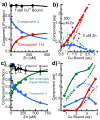The prion protein is a combined zinc and copper binding protein: Zn2+ alters the distribution of Cu2+ coordination modes
- PMID: 18034490
- PMCID: PMC2532507
- DOI: 10.1021/ja077146j
The prion protein is a combined zinc and copper binding protein: Zn2+ alters the distribution of Cu2+ coordination modes
Abstract
PrP binds copper in the highly conserved, unstructured N-terminal half of the protein. The octarepeat region consists of 4 tandem repeats of PHGGGWGQ and binds four equivalents of copper at full occupancy. Adjacent to the octarepeats are two additional histidines that may also bind copper. We recently showed that when the octarepeat region is titrated with Cu2+, the copper binding mode depends on the number of equivalents of copper bound. In addition to copper, other metals have been associated with PrP, however zinc is the only metal other than copper that induces PrP endocytosis, inhibits fibril formation and promotes inter-molecular interactions. In this work we show that even large excesses of zinc (> 1mM) are unable to displace copper from either the octarepeat region or the full-length protein. However, EPR reveals that physiologically relevant levels of zinc significantly alter the distribution of copper among the available binding modes. Diethyl pyrocarbonate (DEPC) modification and Mass Spectrometry is used to identify the octarepeat region as the zinc binding site and to confirm that the affinity of PrP for zinc is ~200 μM. PrP can simultaneously bind both copper and zinc by shifting to binding modes that minimize the ratio of histidines to copper.
Figures


References
Publication types
MeSH terms
Substances
Grants and funding
LinkOut - more resources
Full Text Sources
Molecular Biology Databases
Research Materials

